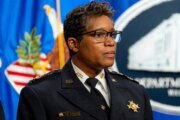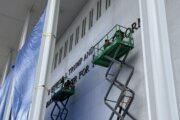How do you feel about traffic circles? Do they improve traffic flow or make it worse? What’s been your experience? Post a comment in this story, comment on WTOP’s Facebook Page or use #WTOPTalkback or #WTOP on Twitter.
Adam Tuss, wtop.com
WASHINGTON – Round and round in the traffic circle you go — and where to get off, does anybody know?
The D.C. area is filled with tricky roundabouts and traffic circles. Dupont Circle, Chevy Chase Circle and Memorial Circle are just a few.
But who has the right of way?
Circles with lights or stops signs regulate themselves, but what about the circles without signals?
Local transportation leaders spell out the rules.
“Basically, it’s the traffic within the circle that has the right of way,” says Bill McGuirk, traffic signal engineer with the D.C. Department of Transportation.
“If you’re approaching a roundabout, you should yield to the traffic within the circulating roadway,” says Cedric Ward, director of the Office of Traffic Safety with the Maryland State Highway Administration.
“There’s only one place you have to look when you are approaching a roundabout, and that is to your left to make sure there is a gap. As soon as you have that gap, you have the right of way.” says Randy Dittberner, traffic engineer with the Virginia Department of Transportation.
But still, many are confused by the circulating flow.
“I think people just do whatever they want,” said D.C. resident Lysette Howels as she walked through Dupont Circle in the District.
Alexander Rinkus, who lives in the District, says he has had to circle around more than once inside a traffic circle because of the confusion.
“I would rather go around one more time than be the guy who is trying to cross three lanes of traffic in the span of about 15 feet,” he says.
So why are there so many traffic circles in the area in the first place? A lot of them were inherited, says McGuirk.
“It goes back to the L’Enfant days. When he [Pierre Charles L’Enfant] was laying out the city, the circles basically were set up as defensive positions, and they were used to protect the White House,” says McGuirk.
“They kind of radiate out from the White House.”
Of course, traffic has increased since those days, and many of the city’s traffic circles needed to adopt signals to handle the heavy traffic flow.
Along more rural sections of road with higher speeds, drivers are more likely to encounter traditional roundabouts. The more traditional roundabout doesn’t typically allow pedestrians in the middle section, like circles might.
Dittberner sees them as a valuable tool.
“Roundabouts have a couple of good features that help make them much safer than intersections. They require all traffic to slow down on approach, so everybody is going slow and everybody is aware they have to watch out for each other,” he says.
“They are beginning to be much more popular in the U.S. We are really beginning to understand the benefits of these devices,” says Dittberner
Whether local pedestrians and drivers agree, that’s another matter.
Related Stories:
WTOP’s Kandace Redd contributed to this report. Follow Adam and WTOP on Twitter.
(Copyright 2012 by WTOP. All Rights Reserved.)







